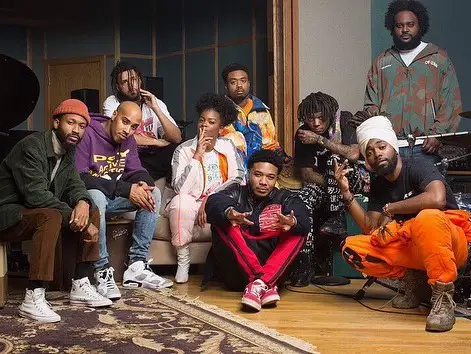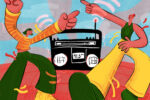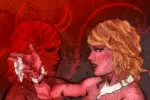Dreamville’s new compilation, “Revenge of the Dreamers III,” carries an electric and dynamic energy. Dreamville is hip-hop king J Cole’s label, which consists of about eight artists that each contributed to and are featured on the album. However, “Revenge of the Dreamers III” doesn’t consist of exclusively Dreamville artists.
Instead, Dreamville set the intention to create a space bred for collaboration — they wanted their creative inspiration to come from a place of alliance. Surprisingly, the entire album was recorded in just 10 days.
Studio sessions took place in Atlanta, Georgia, which many of the Dreamville artists hail from originally. They sent out invitations to 343 artists and hip-hop producers around the world, providing a sense of personalized inclusivity.
The power that these eight artists display on the album portrays their unwavering hold on the hip-hop game today. Most tracks on “Revenge of the Dreamers III” radiate confidence with an unstoppable force of animation. The album is split in terms of the theme and sound of the track list.
Half of the album is filled with trap-heavy infused beats, but the flow does not match the relaxed, drugged-out cadence that is common within this style of rap. Instead, each featured artist has a distinguished voice that makes their presence known. The sound is rambunctious and energetic, making the tone ring true to the pursuit of revenge. The other half of the album displays the heart and emotional depth that these artists can so meaningfully pour into a track.
Dreamville knows their skills and mastery lie in being able to create a therapeutic and poetic feel to their songs. Some songs feature a groovy, neo-soul sound with moments of lyrical superiority that are inspired by their ability to conquer moments of defeat, and their special studio sessions allowed for moments of intense reflection about each artist’s journey.
Before each of these incredibly gifted artists started writing music, they were deemed underdogs and pronounced as failures to society. “Revenge of the Dreamers III” acts as each artist’s fight song against the world — after they have ascended above all expectations and limitations. A violent and chaotic vibrancy is displayed best on tracks like “Down Bad,” “Wells Fargo” and “Costa Rica”.
“Down Bad” has a haunting synthesizer that ignites the beat, and harsh trap drum lines that are dropped randomly in the background like bombs. The song features JID, Bas, J. Cole, EarthGang and Young Nudy. JID seems like he is levitating on the hook, and his flow reaches new heights as his voice tries to keep up with each drum line.
The high-pitched vocals land on each punchline like a fist as he spits, “I was just f—d up, I was just down, down bad. I had to tighten the f—k up, but I’m here for the crown. Board of Education vs. Brown, I was bored of education, left the town.”
JID uses his lyrical capabilities to paint a picture of him as an adolescent who was always getting into trouble; he was dubbed a bad student because of his lack of interest in standard education.
He touches on how broken the education system is for young, African American males by referencing the Supreme Court hearing of Brown v. Board of Education, which declared racial segregation in public schools unconstitutional. JID also alludes to the way society prioritizes and stresses traditional education as the only path to success.
In the next verse, J. Cole offers deeper insight into the past obstacles that each artist had to overcome before they could achieve their dreams. He raps, “Dreamville head honcho, we came from nothing just like the big bang theory. That poverty stains kept the pain buried and covered the shame with a dream. We would have fortune and fame.”
Cole has been known for highlighting the harsh realities that many people undergo within the hip-hop and African American community. He exposes the impact that poverty has had on each of the artist’s lives. He also reveals the ideology that was embedded in each of them as the only way to gain recognition and respect.
Again, Dreamville alludes to the way materialism is implanted into society as a necessity and a symbol of success. J. Cole conveys that the many different levels of poverty, paired with abuse that was supposed to keep them down, only fueled each artist to manifest their own dreams.
On the track “Sleep Deprived,” the artists speak on how long their dreams have taken to come into fruition against hesitation and insecure thoughts. Self-doubt and panic lingers in the background of the track like fog. Dreamville uses a metaphor of being sleep deprived to instill the level of devotion each artist had toward making their dreams a reality.
The song’s beat has a loopy, R&B-inspired feel to it and is mixed with soft piano keys that sound like a distant whisper. Lute’s verses stress the importance of artistic expression as a means to get out of poverty and how a creative outlet can contribute toward self-growth.
“I met this girl the other day that wants to know my story; she said since the world against me, she all for me,” he raps. “I told her God must have overhead my hopeful wish. It’s crazy how I never would’ve thought to be in this position. See, ‘hip-hop saved my life’ is such a cliché quote, but before I grabbed the mic, I was the poster child of broke.”
Lute’s voice sounds like he has the whole word strapped to his back, carrying the weight of all his past insecurities wherever he wanders. His verse acts as moment of realization — Lute’s eyes have finally opened, so he can now see the full progression that art has allowed him to achieve. Self-love undermines the pain of the turmoil that used to overwhelm him.
Artist DaVionne is also featured on “Sleep Deprived,” and her verses nurture a faith that she had to create for herself. It seems like DaVionne is looking into a crystal ball as she takes us through her moments of weakness and defeat. She is able to see beyond her struggles and is certain she will conquer anything that is placed in her way.
“I ain’t never had nothing, yeah I had to work for it,” she sings. “I built from the ground up, played in the dirt for it. We all come from a very different path. Look at what we’ve been through, look at where we at. We got them losing sleep, worried about what we on. They said I wouldn’t make it, but I always prove wrong, yeah.”
Her verses perfectly sum up the essence of the intention set for “Revenge of the Dreamers III.” The album is an expression of gratitude for how far they have come and their faith for the future.
Dreamville also released a documentary that catalogues the 10 days of recording sessions and captures the family vibe that happens when everyone comes together in one space. J. Cole speaks on the creative gift that comes with being surrounded by like-minded artists.
“I’m happy for all these producers and artists that have never had an experience like this — I’ve never had an experience like this, and I’ve been in this game 10 years. Sometimes, it’s easy to lose hope as an artist or a producer in this game. I feel like, honestly, more things like this would just do so much for music. Period.”
















